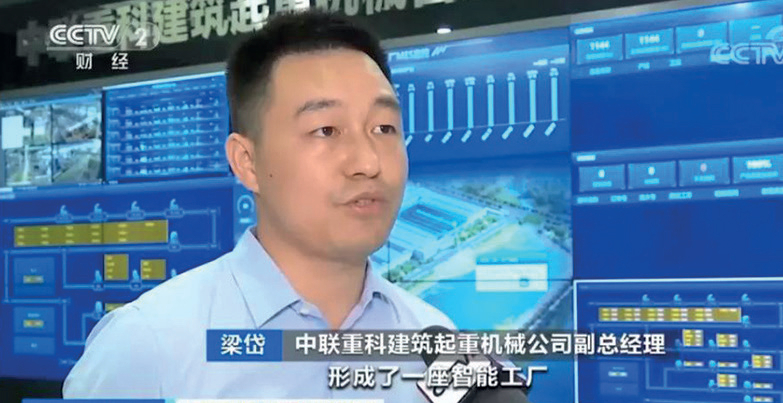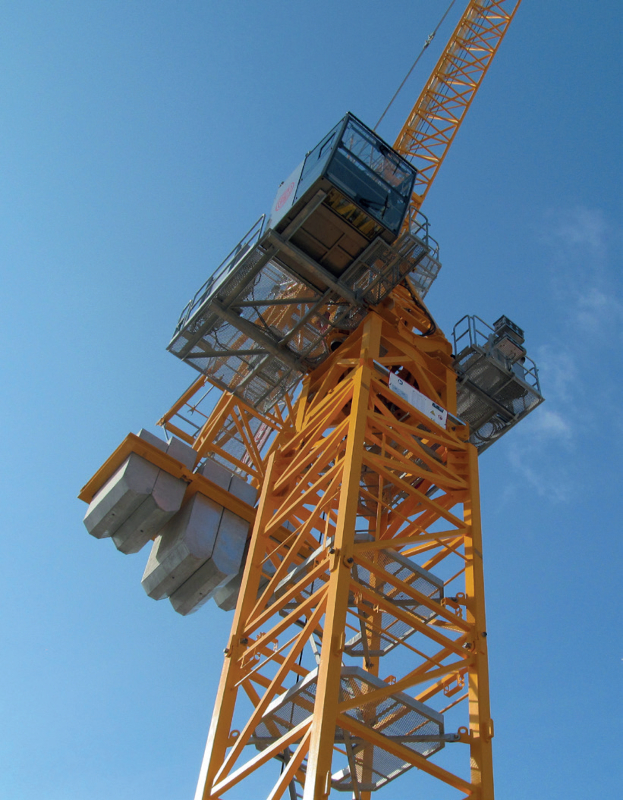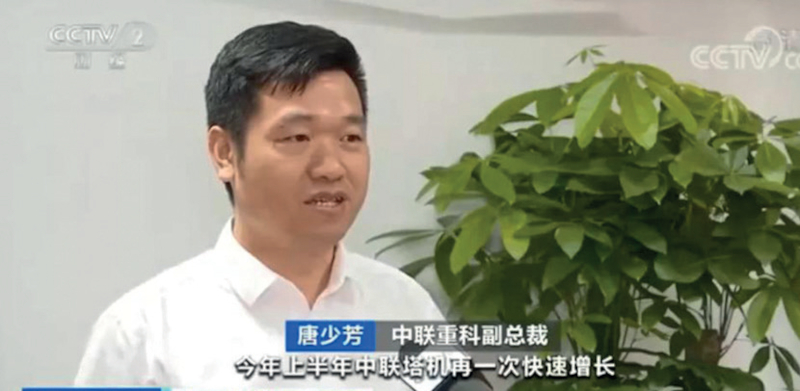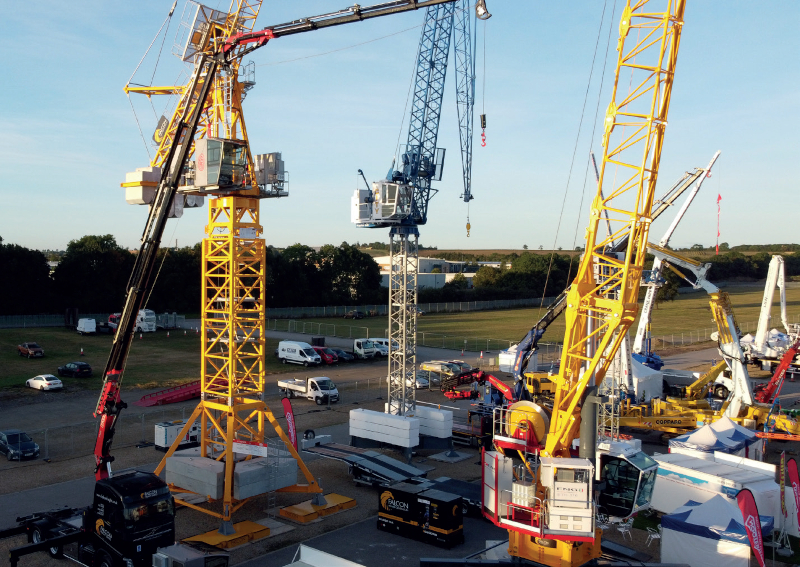Dragon Dynasty?
28 October 2021With the stated aim of increased international expansion what stands in the way of Chinese manufacturers gaining market share in traditional, established tower crane markets? Christian Shelton reports
With new, cutting-edge production capabilities both home and abroad, improved products, and strengthened sales and service networks, Chinese tower crane manufacturers are well placed to capitalise on an already buoyant global tower crane market in a post-Covid landscape.
In Europe demand for tower cranes has remained relatively high for both rental firms and manufacturers throughout the pandemic. Having been deemed ‘essential’, work on many prestige, infrastructure, and large-scale residential projects continued throughout lockdown.
And as we emerge from the pandemic infrastructure spend in many countries has increased as governments invest to stimulate growth.
The continued adoption of prefabricated, prefinished volumetric construction (PPVC) building techniques around the world is further fuelling tower crane demand.
As a result, they have largely remained a reassuring sight, a signature of progress, across skylines of cities in both developing and developed countries.
POST-PANDEMIC DEMAND
Emerging from the pandemic has also increased demand for tower cranes as rental firms are recommencing projects that had been put on hold, plus accepting a raft of new commissions.
Adding to this, many tower cranes have been stuck on existing jobsites for longer than expected due to the slowing in work rate due to anti-Covid and social distancing measures. To cover demand some rental firms have boosted fleets by buying new equipment.
Yet juxtaposed against the rapid rise of Chinese-made tower cranes, in terms of both increased unit production rates and market share in developing markets (where price is king), is the robust nature of the established tower crane elite in Europe, the USA and Australia as secure as it first appears?
ONE TOWER CRANE PRODUCED EVERY 18 MINUTES
In terms of tower crane production, Chinese manufacturer Zoomlion says it is increasing output rapidly, with claimed tower crane sales exceeding RMB 10 billion (£1.13 billion) for the first half of 2021.
Key to this is the establishment of its intelligent tower crane plant which opened in Changde, Hunan Province, in May. According to Zoomlion the factory utilises cutting-edge technology and is operating at full capacity producing one tower crane every 18 minutes.
Zoomlion says that in 2021 it has only taken six months for it to reach its total annual sales of 2019 boosted, in part, by a $70 million order early on this year from Chinese steel company Panhua.
"In the first half of this year, Zoomlion once again saw growth by leaps and bounds, with its tower crane sales exceeding RMB 10 billion, which took the company nine months to realise in 2020 and 12 months in 2019,” said Tang Shaofang, vice president of Zoomlion. “The company has been growing increasingly rapidly.”
“It is expected that our overall production capacity will double on the basis of the first half of the year,’ added Liang Dai, Zoomlion deputy general manager of construction lifting machinery.
ECONOMIES OF SCALE
Chinese manufacturer XCMG also claims rapid growth rates for its tower crane output. It stated a 2021 sales target of RMB8billion (£0.9 billion), up RMB2.5billion on its claimed 2020 profit of RMB5.5billion (£0.62 billion), made from the sale of over 10,000 tower crane units. XCMG claimed turnover of around RMB3 billion in 2019, RMB1 billion in 2018, and RMB500 million in 2017.
In addition, a new tower crane factory in Foshan, Guangdong province, is planned to start production imminently further increasing the company’s economies of scale. XCMG aims to produce 600 tower cranes in the under 600 tonne-metres class per month.
XCMG has invested RMB2 billion (US$ 306 million) in the new factory, which will serve south China. Once up and running cranes of more than 600 tonne-metres will be produced in XCMG’s Xuzhou (HQ) factory, which is also being massively expanded.
BUILDING BRAND LOYALTY
Other than significant, targeted investment what underpins these large increases in production rates for Chinese manufacturers? Price-point, international expansion of sales and service networks, and increasing end-user confidence in Chinese equipment and technology all play a part.
Both XCMG and Zoomlion already enjoy large market shares in developing countries where many crane owners buy equipment based primarily on price. One positive effect of this for the Chinese is that they are sewing the seeds of brand loyalty in these (rapidly) developing countries.
Add to this the inroads they are making overseas with both production and sales and service networks.
Zoomlion’s new tower crane assembly plant in Solferino, in the North of Italy, for example, (see: www.cranestodaymagazine. com/features/investing-ineure- 8813842/) is explicitly designed to aid the company’s expansion into Europe. Zoomlion Group’s management says it identified Europe as a key strategic market for the expansion of its international business and this was a key reason behind investing in a new European plant.
THE FULL LINE-UP
Since 2020 Zoomlion has offered two flat top tower cranes to the European market: the 12 tonne capacity T7020-12 and the eight tonne T6515-8. It now plans to launch two more heavy duty flat top tower crane models: the 205 tonne W6522- 10 and the 270 tonne W7025-12.
“From September 2021, the development of the second phase begins, which among others includes the introduction of heavy flat top cranes, in order to have a full range of flat tops in 2022,” comments Petre Babiceanu, general manager, Zoomlion Europe.
Babiceanu also hints that luffers might soon be added to the company’s European line-up, “We are aware of the importance of having a complete range (flat tops and luffers) in order to be able to introduce the Zoomlion brand throughout Europe and achieve excellent market share, even in countries such as the UK where the luffing jib crane is king. Zoomlion’s R&D department is working on it.”
QUALITY COMPETITION
One factor Chinese companies will need to contend with if they wish to gain traction in established tower crane markets is the quality of the competition in terms of both volume and the high-end nature of cranes produced. This year alone, for example, we have seen a plethora of new tower crane launches and upgrades from multiple manufacturers.
The most recent launch comes from Spanish manufacturer Jaso in the form of the J198HPA hydraulic luffer which the company says will be one of the biggest on the market. The crane has a maximum capacity of 18 tonnes. Jaso says it has been built in response to growing demand for higher capacity cranes within the 200 to 350 tonne-metre range for urban projects or high-rise construction in congested inner cities.
In March, USA-headquartered crane manufacturer Manitowoc launched the eight-tonne capacity Potain MCT 185 for the Asian market. The crane is at the lower end of Potain’s topless range. It has a 65-metre jib and can be transported in five containers.
Based on the positive reception the MCT 185 received, Manitowoc added to its Potain line-up in July with the launch of the MCT 135 – available in six-tonne or eight-tonne versions. The crane has a maximum jib length of 60 metres and a height under hook of 50.9 metres. Both cranes are being built at Manitowoc’s Zhangjiagang factory in China.
Manitowoc also expanded its MDT flat top range with the Potain MDT 489, available in 20 and 25 tonne versions.
Also in March, Jaso also entered the flat top tower crane market for the first time with the development of the ten-tonne capacity J200.10 and 12-tonne capacity J200.12. Both cranes were aimed at bridging the gap between city cranes and low top tower cranes.
Another Spanish manufacturer Comansa has added two new flattops to its 21LC series this year: the 21LC600 and 21LC650. Both have improved load capacities. Comansa has also upgraded its 11LC and 16LC series, which now have a new design for the cathead and jib sections. It also launched a new six-tonne version of the 11LC150 which has Comansa’s Quick Set system designed to reduce set up and calibration time
Italian tower crane manufacturer ENG Cranes has launched the ETH96 hydraulic luffing jib tower crane designed to eliminate oversailing issues (see: www. cranestodaymagazine.com/news/ luffer-designed-to-eliminate-oversailing- issues-9001336). The crane has a maximum jib length of 41 metres with an out of service (OOS) parking radius of just 3.8 metres. Maximum capacity is six tonnes up to a jib length of 41 metres, although this can be increased to eight tonnes.
In June, Switzerland-headquartered manufacturer Liebherr launched the ten tonne capacity 205 EC-B 10 (full story here: www.cranestodaymagazine. com/news/liebherr-extends-ec-b-series- 8873273). The maximum capacity is available to a radius of 18 metres and it has a hook height of 54.4 metres. According to Liebherr, the first new models have already sold in France and Italy.
In August, Italian manufacturer Moritsch launched the ten-tonne capacity Moritsch RTM200 flat top. It has a 65 metre jib and a tip load of 2.2 tonnes. The company is also planning to launch a six-tonne version (RTM130), an eight-tonne version (RTM170); a 12-tonne version (RTM250); and a 16-tonne version (RTM300). An 18-tonne low top (the RTT 350) is in the pipeline aimed at customers in North America and Northern Europe.
With regards to luffers, following the successful launch of its 16 tonne RTL195 luffer with a low (eight metre) out of service ratio Moritsch is now pushing its new 18 tonne capacity RTL265K, particularly in Middle Eastern and Asian markets, with the first eight cranes going to Korea. The company is also planning to launch a ten-tonne capacity RTL155, and a 24-tonne RTL505 luffer (aimed at Asia, Australia, North America and the UK).
Also this year Spanish tower crane manufacturer Sáez has launched increased tip capacity updates of its flat top TLS 75 16T and TLS 80 24T models (the TLS 75B 18T and the TLS 80 20T) and it is also planning launches for a 36-tonne capacity luffing jib, the SL 730, and the SL 730 ROS with reduced out of service ratio.
MANUFACTURER AND CUSTOMER COLLABORATION
Another area Chinese crane manufacturers might find tricky to navigate in trying to break into established markets is the element of close collaboration that exists between some manufacturers and rental firms, resulting in the cooperative development of tower cranes with specific attributes.
Both Jaso’s J198HPA and ENG Cranes’ ETH96, for example, were developed in close collaboration with UK tower crane rental firm Falcon Tower Cranes. Falcon has ordered five units of Jaso’s J198HPA and five ETH96s. Andrew Brown, managing director of Falcon, explains, “We’ve worked with Jaso since the early 2000s but more recently we’ve been working with them a lot to develop new models. We like to have input, especially to help make them erection-friendly. With the J198HPA, in particular, we spent the last year working closely with Jaso to ensure it can be erected in a day.
“We’ve known ENG for about two or three years now. I approached Massimo at ENG about six months ago as we wanted a hydraulic luffer that had a much small out of service radius than other hydraulic luffers were offering. Just a few weeks later ENG returned with the design of the ETH96 which we now have five of on order."
Brown clarifies that there is no minimum order requirement in the relationship. “We are not committed to buying any specific number but the plan is to erect the crane in our yard and then give ENG any feedback or changes we would like to aid erection. They are open to changing designs and making any making any improvements we identify.”
DREAMS BECOME REALITY
“Our core business is to manufacture and design custom cranes. We turn our customers’ dreams into reality,” said Massimo De Lazzero, export manager at ENG Cranes. “Everyone now wants something new, something different and we can make this happen. We’re receiving custom orders from around the world – from Australia, Canada, and across Europe. These companies are pleased to find someone who listens to them. I always say, ‘if it’s technically possible, then we never say no!”
Manufacturer Wolffkran also has a history of collaboration with customers to develop new products. Its Wolff 235 B, for example, which was launched in 2020, has design features that were requested by the manufacturer’s UK customers. “The Wolff 235 B was developed in close collaboration with Wolffkran customers from the UK, who have decades of experience in handling luffing cranes on inner-city construction sites,” explained Wolffkran product manager Wouter van Loon. It was due to this that collaboration that the 235 B’s hoisting gear can be positioned on the jib instead of the counter jib, making it possible to reeve the hoisting rope on the ground and thus fully pre-assemble the entire jib, Wolffkran said.
Another example of a close collaborative relationship is between UK rental firm City Lifting and Swedish manufacturer Artic Crane, who manufactures the Raptor articulated jib crane. City Lifting bought its first Raptor ten years ago. “We have had a long working relationship,” commented Stefan Olsson, owner of Artic Crane, on City Lifting’s stand at UK trade show Vertikal Days. “We started working with them in 2008 and the first Raptor was out 2010.”
The collaboration has underpinned the development of recent design features seen on the latest Raptor iteration, the Raptor 85, specifically designed to aid work on confined space projects. These include tower mast pins that can be removed internally using hydraulic pullers, enabling the crane to be set up and, crucially, easily removed from the lift shafts of buildings when space is restricted, and a reduced OOS radius of just 3.9 metres. “We spoke to Stefan about the pin system,” said Bob Jones, director at City Lifting, at Vertikal Days trade show. “We came to a joint solution and it works really well.”
BARRIERS TO ADVANCEMENT
Will fierce competition and collaborative partnerships be enough to stop the advances of Chinese tower cranes into established markets?
On their own perhaps not. Combined with the existing strong dealer sales and service networks of European and US manufacturers, however, plus cultural and language barriers, progress may not be straightforward for Chinese manufacturers.
Another hurdle for Chinese expansion is the lingering negative perception from end users around product quality, exacerbated by past attempts at penetrating the European market.
Yet with the large amount of money being invested by Chinese manufacturers surely increased market share will follow as memories of the past fade and the increased quality of their products is borne out on the jobsite?
XCMG points out it already has more than ten large international manufacturing bases, with factories in countries including Germany, Brazil, the United States, and India. It claims more than 300 overseas distributors and 40 overseas offices and exports to 187 countries and regions, with overseas income currently accounting for nearly 30 percent of its total income. For the company’s senior management mindset, incresed penetration into established markets is the logical next step.
As well as international expansion, XCMG has continued to increase its R&D investment. It claims more than 7,100 valid authorised patents, over than 1,700 invention patents, 75 international patents, and has successfully completed the formulation and revision of four international standards.
Industry commentators may describe this as an optimistic ‘spread betting’ approach but as the saying goes, ‘fortune favours the brave’.
Zoomlion, too, warns it thinks the valuation of China’s domestic construction machinery enterprises has been massively underestimated and says that, considering its high-speed growth in construction machinery exports, it’s strength and reach should not be underestimated.



